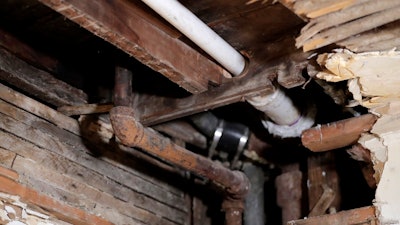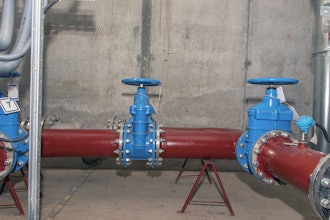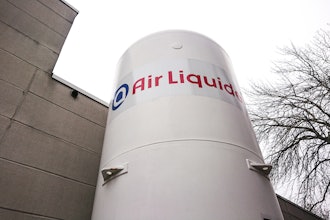
President Joe Biden’s infrastructure plan includes a proposal to upgrade the U.S. drinking water distribution system by removing and replacing dangerous lead pipes. As a geochemist and environmental health researcher who has studied the heartbreaking impacts of lead poisoning in children for decades, I am happy to see due attention paid to this silent killer, which disproportionately affects poor communities of color.
Biden’s proposal includes US$45 billion to eliminate all lead pipes and service lines nationwide. The funding would go to programsadministered by the U.S. Environmental Protection Agency.
This effort would affect an estimated 6 million to 10 million homes, along with 400,000 schools and child care facilities. I see it as one of the nation’s best chances to finally get the lead out of the nation’s drinking water, and its children.
Lead poisoning does permanent damage
Lead poisoning is a major public health problem, because lead has permanent impacts on the brain, particularly in children. Young brains are still actively forming the amazing network of neurons that comprise their hardware.
Neurons are designed to use calcium, the most abundant mineral in the human body, as a transmitter to rapidly pass signals. Lead is able to penetrate the brain because lead molecules look a lot like calcium molecules. If lead is present in a child’s body, it can impair neuron development and cause permanent neural damage.
Children with lead poisoning have lower IQs, poor memory recall, high rates of attention deficit disorder and low impulse control. They tend to perform poorly at school, which reduces their earning potential as adults. They also face increased risk of kidney disease, stroke and hypertension as they age. Research has found strong connections between lead poisoning and incarceration for violent crimes.
The prevalence of childhood lead poisoning has declined significantly in the U.S. over the past 50 years. That’s largely due to the elimination of leaded gasoline in the 1980s and the banning of most lead-based paints.
In the 1970s, nearly 90% of children in the U.S. ages 1 to 5 had blood lead levels above 10 micrograms per deciliter of blood, which then was the “level of concern” under federal health guidelines. Today, according to Centers for Disease Control and Prevention officials, roughly 2% of U.S. children have elevated blood lead levels.
This decline is a public health success story – but researchers estimate that about 500,000 U.S. children still have elevated blood lead levels. In 2012 the CDC adopted a new blood lead “reference value” of 5 micrograms per deciliter or above, which identifies children in the highest 2.5% of those tested for lead in their blood.
Health experts widely agree that there is no known “safe” blood lead concentration. And as long as lead water pipes remain in service, children and families are vulnerable.
No maps of lead service lines
Like many U.S. bridges, roads and ports, America’s water systems are old. Much of the drinking water infrastructure in older cities was built before 1950, before researchers started to grapple with the toxicity of lead.
Most American cities have countless miles of lead service lines buried beneath streets and sidewalks and feeding into people’s homes. Utilities don’t know where many of these aging lines are and don’t have enough data to map them. Replacing them will require significant analysis, modeling, data and some guesswork.
Old service lines have repeatedly caused lead poisoning outbreaks in places like Washington, D.C.; Flint, Michigan; and Newark, New Jersey. The chemistry is a bit different in each case.
 Workers remove water service lines in Trenton, New Jersey, on Jan. 9, 2020. The city is replacing 37,000 lead pipes over five years.AP Photo/Mike Catalini
Workers remove water service lines in Trenton, New Jersey, on Jan. 9, 2020. The city is replacing 37,000 lead pipes over five years.AP Photo/Mike Catalini
Lead service lines typically develop a protective “plaque” of minerals on their inside walls after a short time, which effectively separates the toxic lead pipe from the water flowing through it. This coating, which is called scale, remains stable if the chemistry of the water coursing through it doesn’t change. But if that chemistry is altered, disaster can ensue.
In 2002, Washington, D.C., shifted from chlorine to chloramine for treating its water supply. Chloramine is a more modern disinfectant that does not form dangerous reactive chlorinated byproducts as chlorine can.
This rapidly corroded the protective plaque lining the city’s pipes, flushing highly absorbable lead into homes. Tens of thousands of children were exposed over two years before the problem was adequately identified and fixed.
In Flint, state-appointed managers decided to save money during a fiscal crisis in 2014 by switching from Detroit water to water from the Flint River. Flint river water has completely different corrosivity than Detroit water, but officials did not require enough chemical analysis to determine what additives should be used to maintain the pipe plaque. One egregious and ultimately toxic decision was to forgo the typical step of adding phosphate, which binds chemically with lead and prevents it from leaching out of pipes, in order to save about $100 per day.
Corrosion chemistry is well controlled in many U.S. cities, but it is not a perfect science. And utilities don’t always have detection systems that adequately alert water suppliers to dangers at the tap. That’s why removing lead pipes is the only sure way to avoid the threat of more water crises.
Cities will need to innovate
While $45 billion is a huge investment, in my view it probably isn’t enough to replace all lead pipes nationwide. Take Flint as an example. The estimated cost of replacing all of the city’s lead service lines is about $50 million. As a rough calculation, then, for $45 billion, the nation theoretically could remedy slightly fewer than 1,000 Flints.
But there are literally thousands of U.S. cities to fix. Some are smaller than Flint and thus likely cheaper to remediate, but others are much larger.
My own city, Indianapolis, has a population of about 850,000. That’s roughly 10 times as big as Flint, which means 10 times as many households and water distribution end points. What’s more, officials have only a rough idea of where to find the city’s lead service lines. There are ways to statistically model the likelihood that a given portion of the water system has lead service lines, using information such as water main sizes, locations and construction dates, but they are imperfect.
Cities will need to get creative to make whatever funds they get go as far as possible. As one example, I am working with colleagues to develop a citizen science project that will provide thousands of tests for lead at taps around Indianapolis. This effort, a partnership with the University of Notre Dame funded by the U.S. Department of Housing and Urban Development, may augment modeling with real data on levels of lead in homes, and will increase public awareness of this issue.
Lead water pipes are ticking time bombs in cities across the U.S. Other important sources of lead exposure, such as soil and dust contamination, also require urgent attention. But I believe fixing water systems is a critical step toward protecting children from the lifelong burdens of lead poisoning.
This article is republished from The Conversation under a Creative Commons license. Read the original article here: https://theconversation.com/bidens-infrastructure-plan-targets-lead-pipes-that-threaten-public-health-across-the-us-158277.






















